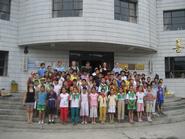
Emily Tang '08 and Aaron Balivet '08 presented their study of the Chinese education system on Nov. 15 in the KJ Red Pit. Having already studied abroad in Beijing through Hamilton's Associated Colleges in China program during their junior year, they were awarded a U.S. Education Department Fulbright Hayes Group Project Abroad grant that enabled them to study the Chinese education system and gain firsthand experience in teaching Chinese students during the summer. The Fulbright Grant is part of the U.S.-China cultural exchange, which sends U.S. citizens to foreign countries to serve as informal cultural ambassadors. The grant is also aimed toward enhancing the quality of basic education in rural China by introducing new teaching styles in rural schools.
Tang and Balivet discussed three main aspects of their experience in field studies: preparation for teaching classes, teaching experience and student reactions to their teaching style. To prepare for their field study Tang and Balivet studied in Beijing for three weeks to understand the basics of the Chinese education system, practice translation and improve their listening comprehension of regional accents. They also designed class lessons such as music appreciation and science, as well as presentations about the American education system to Chinese teachers.
Beginning with a video clip highlighting the lack of educational resources in China, Balivet gave a brief synopsis of the Chinese education system. He noted that one of the largest constraints of the system is standardized tests, which are given after both middle school and high school that determine a student's placement in higher education. These tests, Balivet noted, "Are more rigorous and intensive than SATs" and are not necessarily good assessments of a child's knowledge. In addition, such tests are biased as children in more developed areas tend to score higher.
Following this discussion, Tang spoke about the student life in rural areas of China, where education spending is not a priority. She noted that this lack of interest in education spending often results in inadequate facilities, declining admission rates and few qualified teachers. In addition, the children of migrant families in rural China are considered "at-risk," due to these problems.
Having traveled to Gansu, Shandong and Anhui, Tang and Balivet used pictures and anecdotes to describe their cultural impressions of each province, including dining customs and teaching styles. They also highlighted vast differences across geographic areas, including landscape, culture and development. As they concluded their presentation, Tang and Balivet commented that the most pressing challenge to the modern Chinese education system is ensuring quality education while preserving cultural traditions.
-- by Danielle Raulli '10
Tang and Balivet discussed three main aspects of their experience in field studies: preparation for teaching classes, teaching experience and student reactions to their teaching style. To prepare for their field study Tang and Balivet studied in Beijing for three weeks to understand the basics of the Chinese education system, practice translation and improve their listening comprehension of regional accents. They also designed class lessons such as music appreciation and science, as well as presentations about the American education system to Chinese teachers.
Beginning with a video clip highlighting the lack of educational resources in China, Balivet gave a brief synopsis of the Chinese education system. He noted that one of the largest constraints of the system is standardized tests, which are given after both middle school and high school that determine a student's placement in higher education. These tests, Balivet noted, "Are more rigorous and intensive than SATs" and are not necessarily good assessments of a child's knowledge. In addition, such tests are biased as children in more developed areas tend to score higher.
Following this discussion, Tang spoke about the student life in rural areas of China, where education spending is not a priority. She noted that this lack of interest in education spending often results in inadequate facilities, declining admission rates and few qualified teachers. In addition, the children of migrant families in rural China are considered "at-risk," due to these problems.
Having traveled to Gansu, Shandong and Anhui, Tang and Balivet used pictures and anecdotes to describe their cultural impressions of each province, including dining customs and teaching styles. They also highlighted vast differences across geographic areas, including landscape, culture and development. As they concluded their presentation, Tang and Balivet commented that the most pressing challenge to the modern Chinese education system is ensuring quality education while preserving cultural traditions.
-- by Danielle Raulli '10
Posted November 16, 2007
